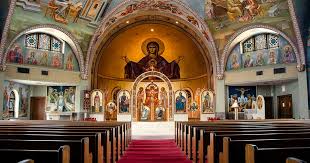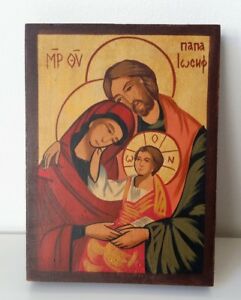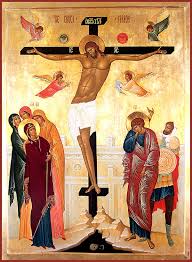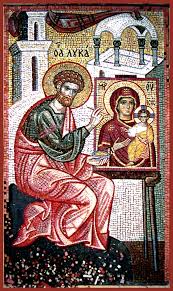The feast of the Transfiguration of Our Lord and God and Savior Jesus Christ is August 6. There is much information online about it. For my “take” on the day, go to: https://frbillsorthodoxblog.com/2019/08/02/137-the-transfiguration-the-other-great-forgotten-feast/
_______________________________________-
I am taking a short break from writing. This article and the next are reprints from August 2019, updated and corrected and improved (slightly).
Introduction
We’re preparing for the Great Feast of the Falling Asleep of the Mother of God on August 15.
The Virgin Mary
Icons with permission of Saint Isaac’s Skete at skete.com (except as noted)
For most Protestants Mary is taboo. There’s no other word for it. She is just unacceptable, forbidden for reasons that cannot be explained.
In Protestant denominations she is almost entirely ignored. She appears in Christmas “creches”, but that’s about it. When I was a boy the only reason I was given for this was because “that’s what Catholics do”. (“Catholics” also believe in Jesus, but I don’t remember anybody taking the argument that far!)
At the Methodist seminary I attended in the early ’60s, her Virgin Birth was mentioned only rarely – in some theology and Bible classes. (In other classes professors demonstrated to us that it was not true. *) The rest of the time she received no attention whatever. Certainly not in worship services.
- The current president of Union Theological Seminary, one of the most prominent liberal Protestant seminaries, says the Virgin Birth is a “bizarre claim”, and then it gets even worse. If you feel you can handle it, see: https://www.nytimes.com/2019/04/20/opinion/sunday/christian-easter-serene-jones.html (I quoted this recently in a class I am teaching and indeed got that “look of incomprehension”, mentioned above, from the cradle Orthodox.)
I was blessed to be introduced to the Virgin Mary when I joined an Episcopalian Anglo-Catholic parish. But even then I was in no way prepared for what I heard when I first attended an English-language Divine Liturgy at an Orthodox Church.
There she was, right in the center up front. (But shouldn’t that have been Jesus?)

Assumption Greek Orthodox Church Morgantown, West Virginia
The Mother of God seemed to be mentioned every few minutes: “Calling to remembrance our all-holy, immaculate, most blessed and glorious Lady the Theotokos and ever-virgin Mary, with all the saints…” And soon afterwards came “Calling to remembrance our all-holy, immaculate, most blessed and glorious Lady the Theotokos and ever-virgin Mary, with all the saints…” (but didn’t they just do that?) – followed by the same thing again! Soon after that it was “Through the prayers of the Theotokos, O Savior, save us” three times. * And so on.
- Visitors to Orthodox churches hear all this because they actually come on time, as opposed to… well, never mind.
There’s more: On Lenten Fridays we sing an “Akathist Hymn” to the Theotokos, where we praise her for about 45 minutes straight. Likewise a similar Paraklysis service to her during the Dormition Fast. I know a Lutheran couple who were inquiring about Orthodoxy and wanted to get a sample of our worship. So they went to a local Milwaukee church and as they approached, the priest trying to be friendly and helpful met them and said, “Come on in. We’re about to sing a service to the Virgin Mary.” They turned around and fled! (They, by the way, are now Orthodox. He is a priest.)
Before we go any further, three things:
1 I’ll take the New Testament text as written. Because I’m a fundamentalist? No. Orthodox don’t do that. Rather because there’s no assured way to get behind the text to find the “real thing”, as some imaginative souls try to do. Most of our popular English-language Scriptural texts are already “twice-translated” – Greek to Latin to English, and with Matthew perhaps “thrice-translated”, first out of Aramaic, the language Christ spoke – so there’s no point in being rigid about them. If at times they seem to disagree, no problem; it’s an unsolvable mystery.
2 So how should we interpret the New Testament texts? “Because the Bible Says So” (above) was only a come-on, so to speak, because the Bible says nothing. Jesus Christ is the Word of God. He is the One who speaks. The Holy Scriptures are the Church’s first written witness to Him, through which He speaks. They were written out of the already-existing Tradition of the Church. They have never stood alone, “Sola Scriptura”. Their words have to be interpreted by someone in one way or another. By Arius or by Luther or that distressing person at Union Seminary, or …. or as they were delivered to us by the Apostles as part of the Christian Way, the Tradition, as we Orthodox call it. It is within that continuing living Tradition of the Church that the Scriptures have always existed and can still be rightly understood. That is how the Apostles wrote the New Testament. That is how the Church understands it. That is what I will try to follow here. (So did the Virgin Birth actually happen? Yes.)
3 For something to be considered “Scriptural”, the precise wording need not be in the Bible. For example, the term “Trinity” is nowhere in the Bible. Yet I think almost all Christians accept it because it accurately sums up what the New Testament teaches.
Now, to business:
Mary in the New Testament
Q. How often is Mary mentioned in the New Testament? A. She is all over the place. 54 times and counting. Other than Jesus Christ himself, who is mentioned most often in the Gospels? His Mother Mary.
Let’s just list the passages here. In the next section we’ll look at their meaning.
1 Her Annunciation by the Archangel Gabriel and his words: “Hail, full of grace. The Lord is with you.” Luke 1:26-38
2 Her visit to her cousin Elizabeth, which includes  Elizabeth’s greeting: “Blessed are you among women, and blessed is the fruit of your womb”, and the Song of Mary which is sung daily at services in both Eastern and Western Christianity: “My soul magnifies the Lord… all generations shall call me blessed.” Luke 1:39-56
Elizabeth’s greeting: “Blessed are you among women, and blessed is the fruit of your womb”, and the Song of Mary which is sung daily at services in both Eastern and Western Christianity: “My soul magnifies the Lord… all generations shall call me blessed.” Luke 1:39-56
3 Her Virginal Conception, Joseph’s angelic visitations , Jesus’ birth. Matthew 1:18-2:23
, Jesus’ birth. Matthew 1:18-2:23
4 Joseph leads her to Bethlehem, Jesus’ birth, the visit of the shepherds. Luke 2:1-21
Let’s stop and look at the Nativity icon below, because it’s so interesting. It tells the entire story of the Birth of Jesus Christ.
In the center in the cave (not a “stable”) are Christ and his Virgin Mother, with the animals. Far above in the center is the Holy Spirit of God presiding over it all. Left above are the Wise Men approaching. Above are the angels, including one instructing the shepherds, right, to go to Bethlehem. Left below is Joseph, feeling “out of it”. Right below is the newborn Baby Jesus being washed up by a midwife. The impossible shapes of the hills tell us that something super-natural is happening here: God in Person “was incarnate of the Holy Spirit and the Virgin Mary, and was made Man.”
5 The visit of the Magi who found “the Child and his Mother Mary”. Matthew 2:1-12
6 The Presentation of Christ in the Temple, and Simeon’s prophecy to Mary that “a sword shall pierce your heart.” Luke 2:22-39
 7 Joseph guides “the Child and his Mother” into exile in Egypt, then returns them to Nazareth. Matthew 2:13-23
7 Joseph guides “the Child and his Mother” into exile in Egypt, then returns them to Nazareth. Matthew 2:13-23
This is a Coptic (Egyptian) Orthodox icon of the Holy Family on the Nile River.
8 Mary “pondered these things and treasured them in her heart”. Luke 2:19, 51
 9 At the Passover in Jerusalem the boy Jesus ran away, and when they found Him in the temple right his Mother scolded Him – scolded God Incarnate! Luke 2:41-51
9 At the Passover in Jerusalem the boy Jesus ran away, and when they found Him in the temple right his Mother scolded Him – scolded God Incarnate! Luke 2:41-51
10 The wedding at Cana of Galilee below where she pushed Jesus into changing water into wine. Note Mary whispering to her Son. John 1:1-12

11 The people of Nazareth reject Jesus, thinking he could not be Messiah because he had grown up there; they knew “his mother Mary” and the rest of his family. Matthew 13:53-48
12 She and his brothers went to see if he was alright, and he was told, “Your mother and your brothers are here.” Matthew 12:46-50
13 As she stood beneath the Cross with John,  Christ said to her, “Mother, behold your son”, and to John, “Son, behold your mother.” John 19:26-27
Christ said to her, “Mother, behold your son”, and to John, “Son, behold your mother.” John 19:26-27
Proceeding beyond the Gospels:
14 “The women along with his mother Mary and his brothers” were part of the earliest Church. Acts 1:14
15 The Mother of God has been glorified in heaven, of which we’ll say much more later. Revelation 12
Have I missed anything?
Is the point made?
How can those who read the Gospels not see Mary? How can anyone who loves Jesus not love his Mother?
What does the New Testament teach about Mary?
First, let’s be clear that the Church believes a lot more about her than what we’ll speak of here. Some of this (for example the names of her parents, Joachim and Anne) is found in very early books not included in the Scriptures. Other parts are based on our experience with her over the centuries. Father Alexander Schmemann wrote a little book called The Presence of Mary. * His point was that if you hang around the Church for a while, you’ll just know she is here. What the New Testament says about her has been “amplified” and developed in the Church over the centuries.
- Now out of print, and I don’t have a copy. Do any here present know where I could find one?
However, for our purposes now, we’ll stick closely to passages from the New Testament.
1 The stories of the Annunciation, the trip to Bethlehem, the birth of the Lord, the visit of the shepherds and more – where did these come from? I’ll add some italics here for emphasis: Luke’s project was “to write… an orderly account, most excellent Theophilus [whoever that was], that you may know the certainty of those things in which you were instructed… just as those who from the beginning were eyewitnesses and ministers of the word delivered them to us.”
 Who was the foremost of these “eyewitnesses”? Luke could not be clearer. He tells us twice so we can’t miss his point. Only one person was there “from the beginning“, and had “kept all these things and pondered them in her heart ” Luke 2:19, had “kept all these things in her heart”. Luke 2:51 The stories came from the Virgin Mary. (This is so obvious. I am amazed that so few commentators remark on it. I am amazed that it took me so long to see it.) Who else could some of the stories have come from? I mean, how many people were present at the Annunciation?
Who was the foremost of these “eyewitnesses”? Luke could not be clearer. He tells us twice so we can’t miss his point. Only one person was there “from the beginning“, and had “kept all these things and pondered them in her heart ” Luke 2:19, had “kept all these things in her heart”. Luke 2:51 The stories came from the Virgin Mary. (This is so obvious. I am amazed that so few commentators remark on it. I am amazed that it took me so long to see it.) Who else could some of the stories have come from? I mean, how many people were present at the Annunciation?
There is an old tradition that when Luke “interviewed” Mary in her latter years, he painted (wrote) the first icons of her – which explains why depictions of her from earliest times have been virtually identical. Only in modern times have “creative” artists tried to depict what they imagine she should have looked like.
2 Should we praise Mary? Should we “address” her personally? Is that Scriptural? Yes. “All generations will call me blessed.” Read these words in context. Elizabeth has just “called” her blessed, right to her face: “How is it that the Mother of my Lord should come to me?… Blessed are you among women”. Mary surely means that all generations will do exactly what Elizabeth had just done: Say the same thing to her, address her, tell her, “call me blessed”. Dear Mary, Mother of my Lord, “Blessed are you among women.” *
* A side issue which troubles some Protestants: Are people “alive” after death, before the General Resurrection, so we can “talk” to them? This wasn’t a big issue when most of the New Testament was written, since not many Christians had died yet. However, Revelation 5:8 describes  the “saints” (God’s holy ones, Christian people) now praying in heaven. Our Lord Jesus said: “God is not the God of the dead but of the living, for all live to Him”. Luke 20:38 The Church’s post-New Testament experience with the saints has borne that out.
the “saints” (God’s holy ones, Christian people) now praying in heaven. Our Lord Jesus said: “God is not the God of the dead but of the living, for all live to Him”. Luke 20:38 The Church’s post-New Testament experience with the saints has borne that out.
Why is this so? Because Jesus Christ has conquered death. He has united Heaven and earth in Himself and broken down the walls between this world and the next. His Church is a family that encompasses both Heaven and earth. His people do not die.
We naturally ask the prayers and help of loved ones and holy ones on the this side of death. Why ever should we not do the same of those on the other side? Furthermore, our “balanced” Orthodox experience with the saints over the years has not turned us away from God. It has led us to love God more.
Be careful here: Don’t take the “spiritualist” route, trying to summon up the dead for a private consultation unrelated to God. That’s dangerous, not because it’s impossible, but because you never know what you’re getting: your departed Aunt Hattie or someone or something pretending to be Aunt Hattie.
This digression is over. Now back to the subject.
3 Is the “Hail Mary” Scriptural? – whether Eastern or Western form? Yes. Most of it is a collation of the words of Gabriel and the words of Mary’s cousin Elizabeth. If it’s good enough for an Archangel and a Saint, it should be good enough for us,
Rejoice, O Virgin Theotokos, Mary full of grace, the Lord is with you. Blessed are you among women, and blessed is the fruit of your womb, for you have borne the Savior of our souls.
4 The title “Theotokos” / θeotόkos, “Birth-giver of God”, “Mother of God”. * Is that Scriptural? Yes. The word itself is not in the Bible, but (like the word “Trinity”) the reality of it certainly is. For the Virgin Mary conceived, carried, gave birth to and is the Mother of Jesus who is God, God Incarnate. The title was adopted by the Fourth Ecumenical Council to counter 1) any followers of Arius who still disbelieved in the divinity of Christ, and 2) those who said Jesus Christ was not a single Person, both God and Man indivisibly united, so that Mary had somehow inexplicably given birth only to the human side of Christ.
- By which we do not mean she is the pre-eternal Mother of the eternal God. That would be absurd.
Therefore we sing: “O Virgin pure, immaculate/ O Lady Theotokos…”
- Written in Greek by Saint Nektarios of Aegina (d. 1920)
- Sung so beautifully by “Eikona” from Orthodox Christian Chants site (well worth checking out): https://www.youtube.com/channel/UC2eQY65jlYsdDuevEUE9CGQ
- First verse: O Virgin pure, immaculate/ O Lady Theotokos, O Virgin Mother, Queen of all/ and fleece which is all dewy. More radiant than the rays of sun/ and higher than the heavens Delight of virgin choruses/ superior to Angels. Much brighter than the firmament/ and purer than the sun’s light. More holy than the multitude/ of all the heav’nly armies.
Refrain: Rejoice, O Unwedded Bride!
It goes into English after this.
I intended this to be a single article, but I’ve got so caught up talking about the Theotokos that we’re going to have to stop now and finish next week. We’ll pick it up with “Does the Bible teach that Mary is Mother of Christians?” (The answer, of course, will be Yes.)
Next Week: Part Two of Why do we honor Mary? Because the Bible says so!